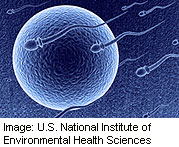
THURSDAY, May 29, 2014 (HealthDay News) — Sperm are highly adept at swimming against a current, new research shows.
This finding may help explain how sperm cells can travel the long distances necessary to reach and fertilize an egg. And, that could lead to more efficient artificial insemination techniques, according to the researchers.
“We wanted to know which physical mechanisms could be responsible for navigation. If you think of salmon, for example, they can swim against the stream, and the question was whether something similar could really be confirmed for human sperm cells,” Jorn Dunkel, an assistant professor of mathematics at the Massachusetts Institute of Technology, said in an MIT news release.
Because observing sperm swimming in the human body is too difficult, Dunkel and colleagues conducted lab experiments in which they changed the flow of fluid in specially designed tubes, to observe how sperm responded to different current speeds.
They noted that hundreds of millions of sperm begin the journey, but only a few ever reach an egg. They have to swim in the right direction over distances that are about 1,000 times their own length, and are exposed to different chemicals and currents along the way.
At certain current speeds, sperm will able swim very efficiently upstream, according to the findings in the journal eLife. The researchers also noted that the sperm don’t swim upstream in a straight line. Instead, the swim in a spiral motion near the walls of the tube, where the current flow would likely be slower.
“We found that if you create the right flow velocities, you can observe them swimming upstream for several minutes,” Dunkel said. “The mechanism is very robust.”
The researchers are planning to examine whether sperm work together to reach an egg.
“It is a commonly held belief that there is competition between sperm cells, with the fittest reaching the egg first,” Dunkel said. “But recent studies by our team and others show that sperm practically always accumulate at the surface of a tube, and you can end up with a high local concentration of sperm cells, so there could actually be cooperation among these cells that allows them to swim faster collectively.”
More information
The National Library of Medicine has more on male infertility.
Copyright © 2025 HealthDay. All rights reserved.

